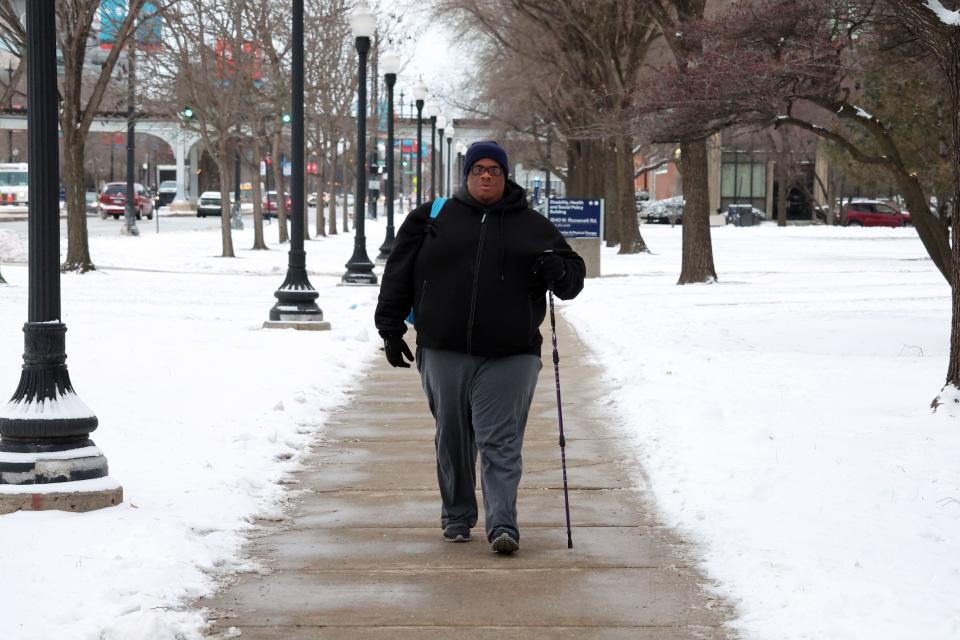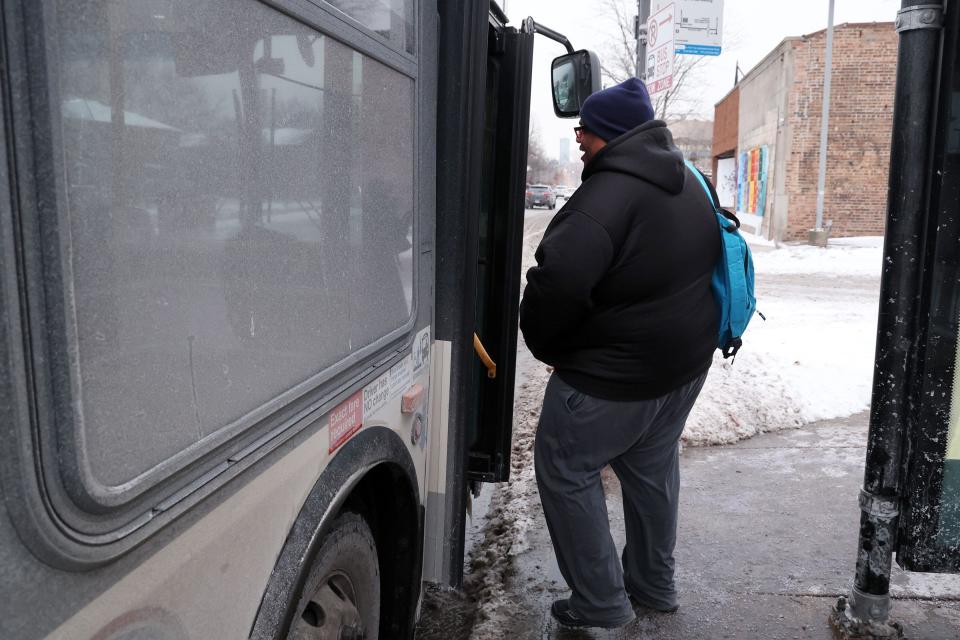‘Locked in’: Chicagoans who use wheelchairs, mobility aids struggle to navigate city’s sidewalks during snowstorm
While T.J. Gordon has used a walking stick consistently for the past two years due to chronic leg pain, he typically relies on his legs and public transportation to get him where he needs to go in the summer.
But winter is harder, the 36-year-old research associate said.
Last week was too cold for him to wait half an hour for a bus to take him to his home in Lakeview from his job at the University of Illinois Chicago. His leg pain also made it much too long for him to stand. He instead depended on taxis — a cost that quickly adds up — or ADA Paratransit, a transportation service for people with disabilities. The sidewalks can be difficult to traverse, especially at crosswalks, he added.
“The older I get, the more I’m susceptible to slips,” he said. “Granted I can still catch myself before I fall, but I think the last couple years I might have slipped and fell on the ice at least twice.”
Some Chicagoans who use wheelchairs and mobility aids say it’s challenging to navigate the city’s sidewalks when extreme weather grips the region, like last week. Wind chills descended to nearly minus 30 degrees on Tuesday, while the city saw 1.5 inches of snow Friday morning.
Disability and transit advocacy organizations are calling on the city to improve conditions, referencing a program that could require the city to clear some sidewalks in winter.
In Lakeview, Gordon said sidewalks are usually salted. But he said it’s often “treacherous” at crosswalks and intersections. Other places he’s lived seemed better equipped for the cold. In Minnesota, for example, he said paths were cleared quicker. He said there were also more tunnels and pedways that didn’t require standing outside as long.
“If you want to cross the street, you have to hop over big puddles (of slush), whether it’s to cross an intersection or if you try to come off the curb to get out of a car,” Gordon, a co-founder of the Chicagoland Disabled People of Color Coalition, said. “I have long legs, but I can’t jump as far as I used to. I can only imagine those who may rely more on walkers, and even wheelchairs.”
City issues 13 citations
Home, business and property owners in Chicago — and sometimes renters, depending on their lease agreement — are responsible for clearing sidewalks of snow and ice seven days a week. According to the city’s website, snow that falls between 7 a.m. and 7 p.m. must be removed before 10 p.m., and snow that falls between 7 p.m. and 7 a.m. must be removed by 10 a.m.
A 5-foot wide path must be cleared on all sidewalks adjacent to a property, including crosswalk ramps, and they ask that people not shovel snow into the right of way — transit stops, bus pads, bike planes, parking spaces and more. Owners are also responsible for shoveling corner lots.
“Right of way inspectors” enforce the city’s sidewalk snow clearing ordinance, issuing $50 to $500 citations per day to property owners who don’t follow these rules, according to Erica Schroeder, a spokesperson for the Department of Transportation. An administrative hearings judge determines the amount on a “per-case basis.” To report sidewalks that aren’t clear, the city asks that residents call 311 or make a service request online.
“Ensuring that sidewalks are cleared promptly following major snow and ice events is extremely important for the mobility and accessibility of all users of our right of way, especially older adults and people with disabilities,” Schroeder said. “Keeping Chicago’s 7,400 miles of sidewalks clear of snow and ice is everyone’s responsibility — not only is it the neighborly thing to do, but it is also the law.”
In 2024, she said the city has issued 13 citations, as of Friday. However, they’ve received 647 complaints of uncleared ice or snow on sidewalks via the 311 system — which she noted may include multiple reports from the same location.
Last winter, she said the city issued 81 citations but received more than 1,200 complaints.
“Inspectors may opt to issue a warning instead of an immediate fine for first-time violators,” Schroeder said. “The goal is not to issue fines, but to ensure compliance so that people can get around safely.”
‘Trapped’ in her home
For Cherlnell Lane, it feels as if the city isn’t doing enough to make travel safe for everyone. The 41-year-old Washington Park resident has used a wheelchair since 2012 due to arthritis in her knees and back and fibromyalgia.
Navigating sidewalks when there’s snow on the ground is difficult, she said, because her wheelchair can’t gain traction. With ice, the chair’s wheels slip and slide in the same way that a car’s wheels do, she said. If someone doesn’t shovel on her block, she said she’s “trapped.”
Lane loves watching concerts and plays at the Green Line Performing Arts Center, which is close enough to her apartment that she can ride there. When there’s snow on the ground, she can’t visit. She also struggles to go to a nearby food pantry, doctor’s offices, grocery store and religious services.
If snow isn’t cleared, she said it’s also more difficult to take Pace ADA transportation, because she can’t get on the ramp to get into the vehicle.
“It’s frustrating. Another thing it is, which I don’t think people understand, it can be embarrassing for you to want to do something that’s so close, that’s so normal for you to do on a regular basis and now you can’t do it,” she said. “There’s a light shown on how much I can’t do. It hurts.”
If calling 311 doesn’t get results, Lauren Galloway, a staff attorney at Chicago-based Equip for Equality, said she usually advises clients to do “informal advocacy,” such as reaching out to business or homeowners or elected officials directly to fix the problem.
“But it can be difficult when in the moment the snow is blocking your ability to be able to access what you need to access,” she said. “It’s something that continues to be a difficulty for folks.”
Snowplow pilot program in the works
Some activists are looking to shift some of the responsibility for clearing sidewalks to the city, calling the current system “unsafe” and “inconsistent.”
A group of city officials are now designing a publicly funded sidewalk snowplow pilot program, subject to City Council approval. Some aldermen raised concerns when the proposal advanced in July about the costs of the program and location of pilot zones.
The working group will make recommendations by May 31 about the size of the pilot program, the areas included in the pilot and how it will be funded.
If all goes according to plan, Laura Saltzman, a transportation policy analyst for the disability rights group Access Living, which has advocated for the municipal sidewalk clearing program, said the pilot should go into effect next January in a few different areas.
Reports of snow and ice on sidewalks are the most common transportation-related complaint the group gets in winter, Saltzman said. It’s a problem everywhere in the city, she said, but around vacant lots it’s especially pronounced.
It’s understandable that property owners who are blind, use wheelchairs or canes, or are even away on vacation may struggle to clear their sidewalks, she said. She believes it makes more sense for sidewalk clearance to be a government-delivered service.
“We don’t depend on people to clean the streets. Sidewalks are public rights of way,” she said. “Why do we depend on private citizens to clear public rights of way?”
For Lane, it can be challenging to meet her basic needs in winter. But not being able to go places or do things that make her happy is often the most painful. She said she wants people with disabilities to have the same opportunities as able-bodied people.
“Imagine if one day you woke up and all the doors to your houses were gone and you couldn’t get out, because that’s how it is for us,” she said. “We’re locked in.”




